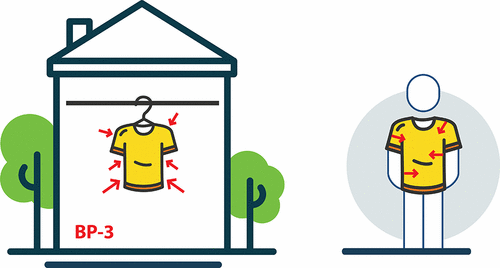当前位置:
X-MOL 学术
›
Environ. Sci. Technol.
›
论文详情
Our official English website, www.x-mol.net, welcomes your
feedback! (Note: you will need to create a separate account there.)
Dermal Uptake of Benzophenone-3 from Clothing
Environmental Science & Technology ( IF 10.8 ) Pub Date : 2017-09-21 00:00:00 , DOI: 10.1021/acs.est.7b02623 Glenn C. Morrison 1 , Gabriel Bekö 2 , Charles J. Weschler 2, 3 , Tobias Schripp 4, 5 , Tunga Salthammer 4 , Jonathan Hill 1 , Anna-Maria Andersson , Jørn Toftum 2 , Geo Clausen 2 , Hanne Frederiksen
Environmental Science & Technology ( IF 10.8 ) Pub Date : 2017-09-21 00:00:00 , DOI: 10.1021/acs.est.7b02623 Glenn C. Morrison 1 , Gabriel Bekö 2 , Charles J. Weschler 2, 3 , Tobias Schripp 4, 5 , Tunga Salthammer 4 , Jonathan Hill 1 , Anna-Maria Andersson , Jørn Toftum 2 , Geo Clausen 2 , Hanne Frederiksen
Affiliation

|
Benzophenone-3 (also known as BP-3 or oxybenzone) is added to sunscreens, plastics, and some coatings to filter UV radiation. The suspected endocrine disruptor BP-3 has been detected in the air and settled dust of homes and is expected to redistribute from its original sources to other indoor compartments, including clothing. Given its physical and chemical properties, we hypothesized that dermal uptake from clothing could contribute to the body burden of this compound. First, cotton shirts were exposed to air at an elevated concentration of BP-3 for 32 days; the final air concentration was 4.4 μg/m3. Next, three participants wore the exposed shirts for 3 h. After 3 h of exposure, participants wore their usual clothing during the collection of urine samples for the next 48 h. Urine was analyzed for BP-3, a metabolite (BP-1), and six other UV filters. The rate of urinary excretion of the sum of BP-1 and BP-3 increased for all participants during and following the 3 h of exposure. The summed mass of BP-1 and BP-3 excreted during the first 24 h attributable to wearing exposed t-shirts were 12, 9.9, and 82 μg for participants 1, 2, and 3, respectively. Analysis of these results, coupled with predictions of steady-state models, suggest that dermal uptake of BP-3 from clothing could meaningfully contribute to overall body burden.
中文翻译:

服装中苯甲酮3的皮肤吸收
将苯甲酮3(也称为BP-3或氧基二苯甲酮)添加到防晒霜,塑料和某些涂料中以过滤UV辐射。怀疑的内分泌干扰物BP-3已在空气中和房屋尘埃中被发现,并有望从其原始来源重新分布到其他室内隔间,包括衣物。鉴于其物理和化学特性,我们假设从衣服中摄取皮肤会加剧该化合物的身体负担。首先,将棉质衬衫在BP-3浓度较高的空气中暴露32天;然后将其暴露在空气中。最终空气浓度为4.4μg/ m 3。接下来,三名参与者穿着裸露的衬衫3个小时。暴露3小时后,参与者在接下来的48小时收集尿液样本时穿了平常的衣服。分析了尿液中的BP-3,代谢物(BP-1)和其他六种紫外线过滤剂。在暴露的3小时内和之后,所有参与者的尿中BP-1和BP-3总和的排泄率增加。参与者1、2和3在最初24小时内因穿着暴露的T恤而排泄的BP-1和BP-3的总质量分别为12、9.9和82μg。对这些结果的分析以及对稳态模型的预测表明,皮肤从衣服中摄取BP-3可能对整体身体负担产生有意义的影响。
更新日期:2017-09-21
中文翻译:

服装中苯甲酮3的皮肤吸收
将苯甲酮3(也称为BP-3或氧基二苯甲酮)添加到防晒霜,塑料和某些涂料中以过滤UV辐射。怀疑的内分泌干扰物BP-3已在空气中和房屋尘埃中被发现,并有望从其原始来源重新分布到其他室内隔间,包括衣物。鉴于其物理和化学特性,我们假设从衣服中摄取皮肤会加剧该化合物的身体负担。首先,将棉质衬衫在BP-3浓度较高的空气中暴露32天;然后将其暴露在空气中。最终空气浓度为4.4μg/ m 3。接下来,三名参与者穿着裸露的衬衫3个小时。暴露3小时后,参与者在接下来的48小时收集尿液样本时穿了平常的衣服。分析了尿液中的BP-3,代谢物(BP-1)和其他六种紫外线过滤剂。在暴露的3小时内和之后,所有参与者的尿中BP-1和BP-3总和的排泄率增加。参与者1、2和3在最初24小时内因穿着暴露的T恤而排泄的BP-1和BP-3的总质量分别为12、9.9和82μg。对这些结果的分析以及对稳态模型的预测表明,皮肤从衣服中摄取BP-3可能对整体身体负担产生有意义的影响。











































 京公网安备 11010802027423号
京公网安备 11010802027423号